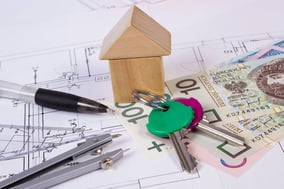The Ins and Outs of Building Your Own Home
For many people, the ultimate dream isn't just owning a home—it's building one. The idea of designing every detail to suit your lifestyle is incredibly appealing. But buying vacant land and building your own home is a different ballgame than purchasing an existing property. It comes with unique steps, opportunities, and challenges. In this post, we’ll break it all down so you know exactly what to expect.
Step 1: Define Your Vision and Budget
Before you even start looking at land, it's important to define what you're building and how much you're willing to spend. Consider:
-
Size and style of home
-
Must-have features (garage, basement, number of bedrooms)
-
Lifestyle needs (space for gardening, privacy, room to expand)
-
Rough construction budget (land + build + permits + extras)
Having a clear picture upfront helps narrow your search and avoid costly surprises.
Step 2: Find the Right Parcel of Land
This is one of the most important steps. When evaluating land, consider:
-
Zoning – Make sure the land is zoned for residential use and aligns with your intended build.
-
Utilities – Is there access to water, sewer, electricity, and internet? If not, plan for wells, septic systems, or off-grid solutions.
-
Topography and Soil – Flat, buildable lots are ideal, but a sloped or wooded lot might offer more privacy or scenic views. A soil test can reveal if the land is suitable for building.
-
Road Access – Is there a legal road or easement to the property?
-
Location – Proximity to schools, jobs, and daily amenities still matters—even when you're building from scratch.
Pro tip: Work with a real estate agent who specializes in land. They can help you avoid red flags and navigate local regulations.
Step 3: Due Diligence
Before finalizing the purchase, you’ll want to thoroughly investigate:
-
Surveying – Know the exact property boundaries.
-
Environmental restrictions – Some properties may be in wetlands, flood zones, or conservation areas.
-
HOA or deed restrictions – Some lots come with rules on what you can build.
-
Permitting process – Every town or county is different. Know what’s required before you close.
Step 4: Financing the Land and Construction
Financing vacant land isn’t as straightforward as a traditional mortgage. You may need:
-
Land loan – Typically higher down payments and interest rates than home loans.
-
Construction loan – A short-term loan that covers the build and later converts to a mortgage.
-
Lot + Construction combo loans – Some lenders bundle both, making the process smoother.
Expect to work with a local lender and provide detailed plans, timelines, and contractor information.
Step 5: Hire Your Team
Unless you're a seasoned builder, you’ll need a solid team:
-
Architect or designer – For customized home plans and maximizing land features.
-
Builder/contractor – Ideally someone with experience building on similar lots in your area.
-
Engineer – For things like septic design or grading plans.
-
Permit expeditor (optional) – Helpful if your area has complex permitting processes.
Get multiple bids, check references, and make sure everyone is licensed and insured.
Step 6: Build!
Once permits are approved and financing is in place, it’s time to break ground. The build process typically follows this order:
-
Site prep and foundation
-
Framing
-
Electrical, plumbing, and HVAC rough-ins
-
Insulation and drywall
-
Interior finishes
-
Exterior work (siding, roofing, driveway, landscaping)
Timeline: Most custom homes take 6–12+ months to complete, depending on size, weather, and complexity.
Step 7: Final Inspections and Move-In
After construction is complete, local authorities will conduct final inspections. Once you get the certificate of occupancy (CO), you can officially move in!
Bonus Tips for Success
-
Plan for contingencies – Costs can creep up. A 10–15% buffer is wise.
-
Think long-term – Choose a location and layout that supports future needs (kids, aging in place, resale).
-
Keep communication open – Regular updates from your builder prevent misunderstandings and delays.
Final Thoughts
Building your own home is a bold and rewarding adventure. With the right knowledge, team, and preparation, you can create a space that’s uniquely yours. If you’re thinking about taking this path, I’d love to help you find the perfect piece of land or answer any questions you have about the process.
Curious what's available in your area? Let’s connect and explore your options.





